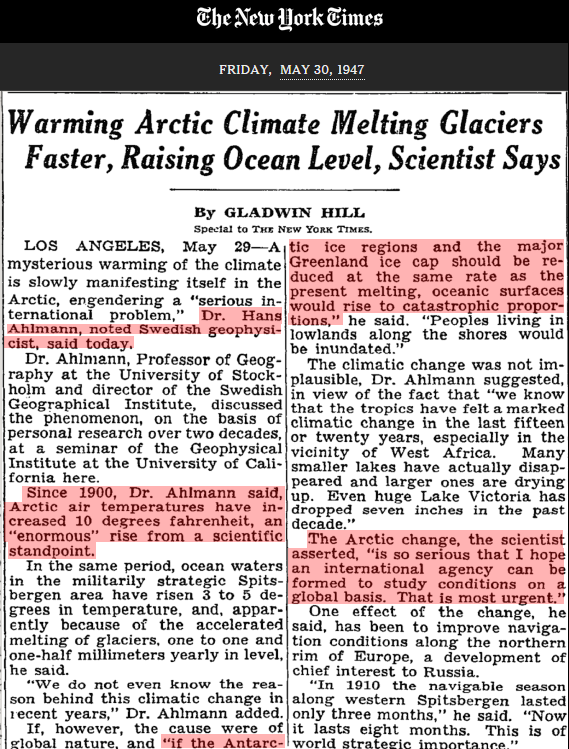Seventy years later – the exact same story. That is why Gavin had to make the warm 1940’s disappear
Disrupting the Borg is expensive and time consuming!
Google Search
-
Recent Posts
- New Visitech Features
- Ice-Free Arctic By 2014
- Debt-Free US Treasury Forecast
- Analyzing Big City Crime (Part 2)
- Analyzing Big City Crime
- UK Migration Caused By Global Warming
- Climate Attribution In Greece
- “Brown: ’50 days to save world'”
- The Catastrophic Influence of Bovine Methane Emissions on Extraterrestrial Climate Patterns
- Posting On X
- Seventeen Years Of Fun
- The Importance Of Good Tools
- Temperature Shifts At Blue Hill, MA
- CO2²
- Time Of Observation Bias
- Climate Scamming For Profit
- Climate Scamming For Profit
- Back To The Future
- “records going back to 1961”
- Analyzing Rainfall At Asheville
- Historical Weather Analysis With Visitech
- “American Summers Are Starting to Feel Like Winter”
- Joker And Midnight Toker
- Cheering Crowds
- Understanding Flood Mechanisms
Recent Comments
- Stuart Hamish on New Visitech Features
- Stuart Hamish on New Visitech Features
- Disillusioned on Ice-Free Arctic By 2014
- Disillusioned on Ice-Free Arctic By 2014
- Disillusioned on Ice-Free Arctic By 2014
- conrad ziefle on Ice-Free Arctic By 2014
- conrad ziefle on Ice-Free Arctic By 2014
- Jack the Insider on Ice-Free Arctic By 2014
- Bob G on Ice-Free Arctic By 2014
- Bob G on Ice-Free Arctic By 2014




As Steve Jobs said:
“You can’t connect the dots looking forward; you can only connect them looking backwards. So you have to trust that the dots will somehow connect in your future. You have to trust in something – your gut, destiny, life, karma, whatever. This approach has never let me down, and it has made all the difference in my life.”
? Steve Jobs
The story from 1947 shows how rapidly Western “science” was corrupted after Stalin emerged victorious from WWII.
It may be the first “science” stories written by Stalin and published in the New York Times after WWII.
The previous year, in 1946, Hoyle reported that astronomers and astrophysicists all unanimously agreed to change the interior of the Sun and other ordinary stars from:
1. Mostly iron (Fe) in 1945 to
2. Mostly hydrogen (H) in 1946
That was perhaps the first step in isolating humanity from reality (God), but that decision was not made public until Fred Hoyle published it on pages 153-154 of his 1994 autobiography.
Stalin’s conclusion about the Sun – the creator and sustainer of every atom, life and world in the Solar System – emerged anonymously in the literature as THE STANDARD SOLAR MODEL. The title informed interested scientists the exact conclusion they would be required to find evidence for if they expected to receive research funds from the government.
The impact of Stalin’s lock-step consensus “science” is illustrated in this one page sequel to Climategate: https://dl.dropboxusercontent.com/u/10640850/Sequel.pdf
I’ve just read an new article saying that “Global flood toll to triple by 2030”. And that leed me back to one thought, that it is shocking to see that there are parts of the worls where water is in excess and provoques floods and there are parts in the world where is a shortage of water and people are suffering from both situations. This is another fact that should draw the attention to the oceans and people shoult start discussing the fact that oceans are main factors that generate climate change and they are the ones that we must pay attention to.
Droughts, at least in the USA are dependent on the AMO/PDO
http://sparkleberrysprings.com/v-web/b2/images/climate07/04mcabefig4lg.png
ARTICLE: http://appinsys.com/GlobalWarming/PDO_AMO.htm
Dr Feynman et al NASA Finds Sun-Climate Connection in Old Nile Records
Monsoons – solar climate
Papers of possible interest:
Solar forcing of the Indian summer monsoon variability during the Ållerød period September 2013
Similar paper from 2001: Evidence for solar forcing on the Indian monsoon during the last millennium
And a try at modeling:
Simulation of the Indian monsoon and its variability during the last millennium
Well obviously they got the money, but it ran out 30 years later. What else could have stopped the warming and lead to the high in Arctic Sea Ice levels in 1978.
Gail – Indian Ocean Dipole is what I have seen as the name for the monsoon cycles.
Thanks, I will have to check that name out.